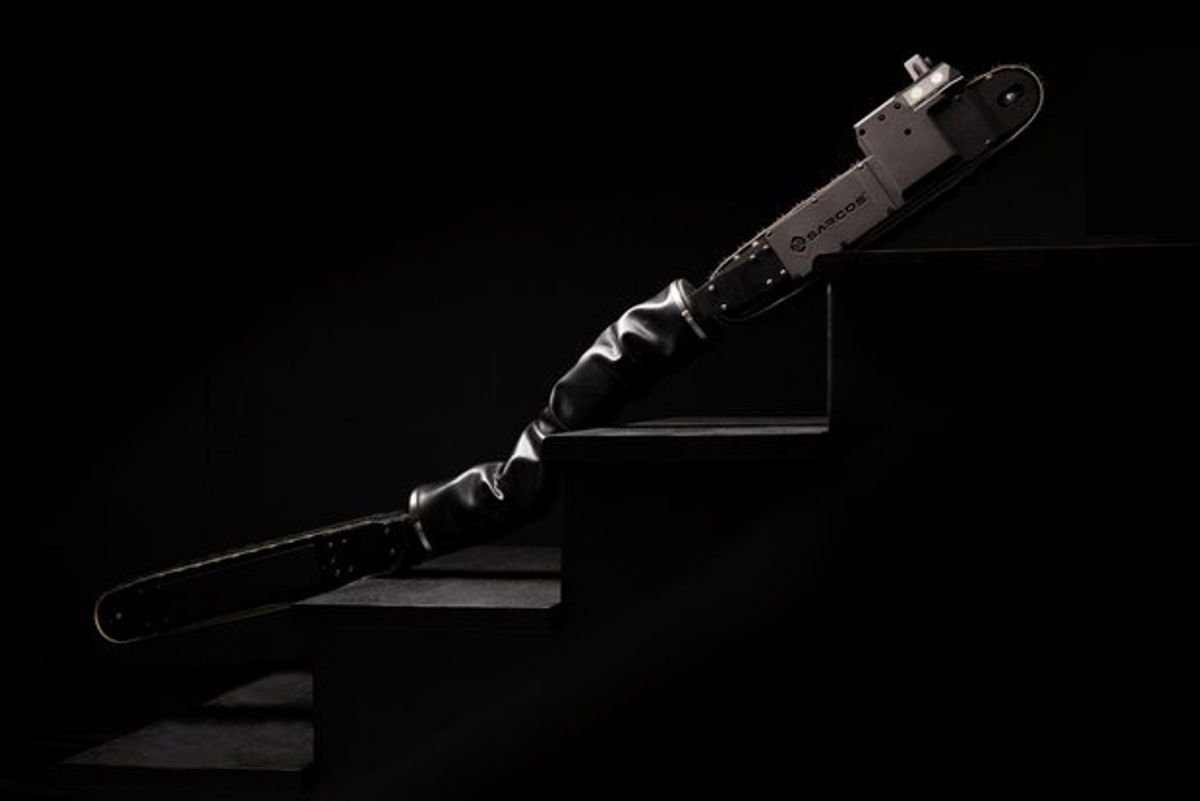Last week, a visitor slithered through the IEEE Spectrum office.
The robotics company Sarcos had brought around its new snake robot, the Guardian S, to show off its moves. While it performed its tricks—shimmying sideways, rolling over, rearing up, and even sliding its magnetized body straight up a metal door—an impressed staff member mentioned that his son would love to have a snakebot to play with. “We’re taking orders if you want one!” said Sarcos CEO Ben Wolff. “Only $60,000.”
Of course, the Guardian S isn’t meant to be a pet or a plaything; the applications Wolff rattles off are in the realms of industry and security. As an agile surveillance agent, the snakebot could conduct inspections in confined spaces or in hazmat conditions, help with search and rescue after a disaster, or assist bomb squads and SWAT teams.
“We wanted to solve the problems that result from humans going into dangerous places and doing dangerous jobs,” Wolff says. The robot’s task, he says, is “to extract information from a dangerous environment.” While drones are increasingly being used for surveillance in such environments, Wolff argues that aerial robots are limited in their flight time and how close they can get to whatever they’re inspecting.
Sarcos, based in Salt Lake City, Utah, wanted to build a versatile robot that could find wide use, so they designed a customizable platform to meet the user’s needs. At its most basic, it simply sends back audio and video from the cameras on all sides of its head. But customers can outfit the 6-kilogram snakebot with up to 4.5 kg of sensors such as gas or vibration detectors. “You dream it up, we can put it in there,” Wolff says.

The base price is US $60,000, with customization costing extra. But Sarcos also offers a “robot-as-service” plan for $2000 per month, which comes with service, training, and upgrades. The company is taking orders now, and Wolff says they’ll start shipping in August.
The Guardian S can run for 18 hours in regular inspection mode, or for 4 hours of continuous driving. The operator guides the bot with a video game-like controller, and can communicate with it using a tether, or wirelessly via Wi-Fi, LTE, or a proprietary radio system.
The robot’s rugged and waterproof body is intended for all types of rough terrain and complex industrial environments, but the Sarcos demo team ran into trouble in the stairwell of the office tower where IEEE Spectrum has its home. The stairs are covered with glossy paint, and the Guardian S climbed only a few steps before it started spinning its treads, unable to get a proper grip. Sarcos president Fraser Smith, who was handling the controls, said they’ve tested the bot on all manner of metal and concrete steps, but not painted ones. “We have to work on that,” he said ruefully, before sending the snakebot downstairs and showing off its ability to climb metal walls.
The current model relies entirely on its operator for navigation, but Wolff says that SLAM is on the company’s research roadmap. He was quick to qualify that statement, though. “With our robots, everything is about augmenting human performance, it’s not about eliminating the human being.” SLAM could make a snakebot easier to use, he says, because it could self-adjust to obstacles faster than the operator could issue commands. “But we’re not interested in having the machines make judgment calls—we always want there to be a human mind in charge.”
Sarcos has been in the robotics business for about 20 years, but the Guardian S is its first product since it reemerged as an independent company after seven years of ownership by the military contractor Raytheon.
Wolff says that after going independent and rounding up investment from the likes of GE, Caterpillar, and Microsoft, the company finally had the mandate and funds to get serious about both a commercial snakebot and a prototype for a new Iron Man-style exoskeleton. Wolff says the prototype of the Guardian XO exoskeleton, which will enable factory workers to easily lift 90-kg loads, should be ready in 2018.
Eliza Strickland is a senior editor at IEEE Spectrum, where she covers AI, biomedical engineering, and other topics. She holds a master’s degree in journalism from Columbia University.




